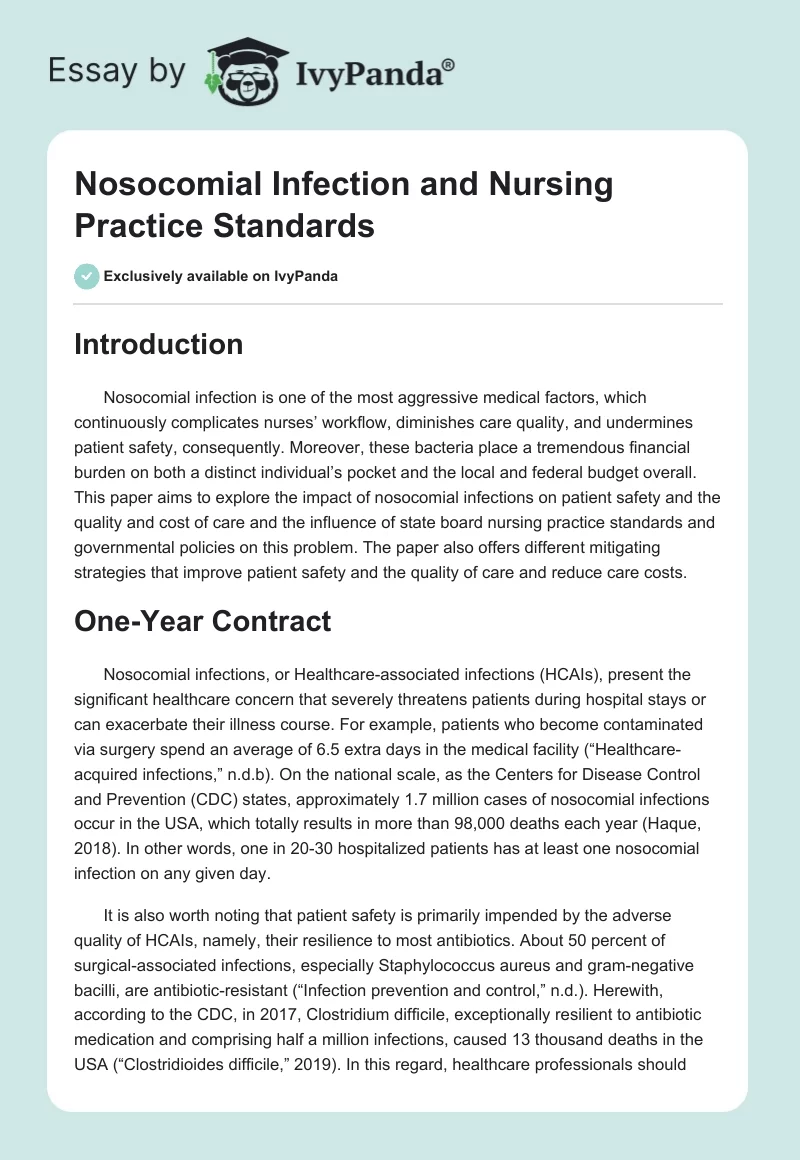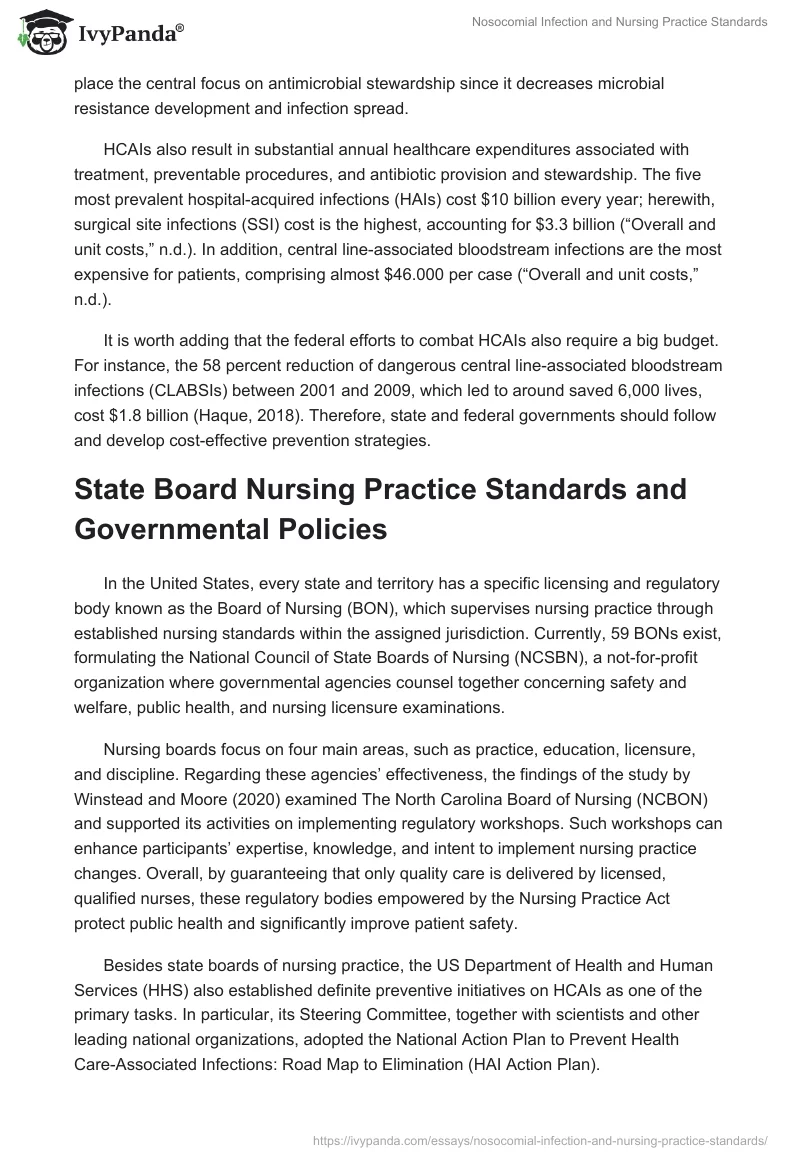Introduction
Nosocomial infection is one of the most aggressive medical factors, which continuously complicates nurses’ workflow, diminishes care quality, and undermines patient safety, consequently. Moreover, these bacteria place a tremendous financial burden on both a distinct individual’s pocket and the local and federal budget overall. This paper aims to explore the impact of nosocomial infections on patient safety and the quality and cost of care and the influence of state board nursing practice standards and governmental policies on this problem. The paper also offers different mitigating strategies that improve patient safety and the quality of care and reduce care costs.
One-Year Contract
Nosocomial infections, or Healthcare-associated infections (HCAIs), present the significant healthcare concern that severely threatens patients during hospital stays or can exacerbate their illness course. For example, patients who become contaminated via surgery spend an average of 6.5 extra days in the medical facility (“Healthcare-acquired infections,” n.d.b). On the national scale, as the Centers for Disease Control and Prevention (CDC) states, approximately 1.7 million cases of nosocomial infections occur in the USA, which totally results in more than 98,000 deaths each year (Haque, 2018). In other words, one in 20-30 hospitalized patients has at least one nosocomial infection on any given day.
It is also worth noting that patient safety is primarily impended by the adverse quality of HCAIs, namely, their resilience to most antibiotics. About 50 percent of surgical-associated infections, especially Staphylococcus aureus and gram-negative bacilli, are antibiotic-resistant (“Infection prevention and control,” n.d.). Herewith, according to the CDC, in 2017, Clostridium difficile, exceptionally resilient to antibiotic medication and comprising half a million infections, caused 13 thousand deaths in the USA (“Clostridioides difficile,” 2019). In this regard, healthcare professionals should place the central focus on antimicrobial stewardship since it decreases microbial resistance development and infection spread.
HCAIs also result in substantial annual healthcare expenditures associated with treatment, preventable procedures, and antibiotic provision and stewardship. The five most prevalent hospital-acquired infections (HAIs) cost $10 billion every year; herewith, surgical site infections (SSI) cost is the highest, accounting for $3.3 billion (“Overall and unit costs,” n.d.). In addition, central line-associated bloodstream infections are the most expensive for patients, comprising almost $46.000 per case (“Overall and unit costs,” n.d.).
It is worth adding that the federal efforts to combat HCAIs also require a big budget. For instance, the 58 percent reduction of dangerous central line-associated bloodstream infections (CLABSIs) between 2001 and 2009, which led to around saved 6,000 lives, cost $1.8 billion (Haque, 2018). Therefore, state and federal governments should follow and develop cost-effective prevention strategies.
State Board Nursing Practice Standards and Governmental Policies
In the United States, every state and territory has a specific licensing and regulatory body known as the Board of Nursing (BON), which supervises nursing practice through established nursing standards within the assigned jurisdiction. Currently, 59 BONs exist, formulating the National Council of State Boards of Nursing (NCSBN), a not-for-profit organization where governmental agencies counsel together concerning safety and welfare, public health, and nursing licensure examinations.
Nursing boards focus on four main areas, such as practice, education, licensure, and discipline. Regarding these agencies’ effectiveness, the findings of the study by Winstead and Moore (2020) examined The North Carolina Board of Nursing (NCBON) and supported its activities on implementing regulatory workshops. Such workshops can enhance participants’ expertise, knowledge, and intent to implement nursing practice changes. Overall, by guaranteeing that only quality care is delivered by licensed, qualified nurses, these regulatory bodies empowered by the Nursing Practice Act protect public health and significantly improve patient safety.
Besides state boards of nursing practice, the US Department of Health and Human Services (HHS) also established definite preventive initiatives on HCAIs as one of the primary tasks. In particular, its Steering Committee, together with scientists and other leading national organizations, adopted the National Action Plan to Prevent Health Care-Associated Infections: Road Map to Elimination (HAI Action Plan).
This plan provides a cohesive, consistent framework for preventing nosocomial infections in ambulatory surgical centers, hospitals, and long-term facilities and directing antibiotic stewardship efforts. For instance, HAI plans require adopting relevant laws and forming the state HAI advisory council or multidisciplinary group to cooperate with local partners, including academic organizations, clinics, and professional societies.
Plans also include onsite public health infection control assessments that appeared to be adequate to train healthcare staff in containment activities and isolation (“State HAI plans,” 2020). Finally, they suggest implementing the Antibiotic Resistance Laboratory Network (ARLN) to detect high-concern and novel resilient organisms. Overall, the HAI Action Plan resulted in considerably improved federal and state coordination attempts to prevent HAIs by sharing resources, best practices, and lessons retrieved from collective clinical experience.
Effective Strategies
Realizing the grave threat of nosocomial infections, national and local authorized organizations develop different elaborated strategies that eliminate or, at least, alleviate the problem’s effect. These strategies are primarily directed at realizing effective preventive methods, infection control, antimicrobial stewardship, research, and reporting. The primary prophylactic measure is frequent, careful handwashing, especially after each contact with patients, equipment, body fluids, and excretions.
For example, a systematic review by Doronina et al. (2017) states that hand hygiene is the most effective practice to avert HAIs, but nurses’ compliance with this practice is still low, indicating the need for education and continuous feedback. Another study by Azor-Martinez et al. (2018) has revealed that hand hygiene programs can reduce respiratory infections, absent days, and antibiotic prescriptions. Another precaution that proves its effectiveness is hospital sanitation which requires providing the safety of clinical rooms, personnel’s uniforms, and equipment for patients. This also implies appropriate hospital waste management, that is, the separate disposal of diagnostic laboratories and waste contaminated with sputum and blood.
Additional preventive practices include personal protective equipment, immunization or vaccination, injection safety, and medication storage and handling. Moreover, medical facilities can also use various available advanced technologies, such as hydrogen peroxide vapor (HPV) and ultraviolet light devices (UV). HAI prevention practices’ financial benefit ranges from $25 billion to $31 billion in healthcare cost savings (“Healthcare-Associated Infections,” n.d.a).
Besides, the benchmark for HAI of Mayo Clinic Hospital at Rochester, a leading national clinic, exceeds the national standard on almost all main infections, including CLABSI, CAUTI, SSI, and Clostridium difficile (“Mayo Clinic,” n.d.). This result has been achieved due to strict adherence to the best preventive strategies and the application of modern technologies that protect medical staff and patients from pathogens.
National and state governments, along with healthcare organizations and hospitals, should pay attention to nurses’ adequate compliance with antibiotic stewardship policies, norms, and standards on antibiotic application and consumption. Research conducted in 88 countries, including the United States, discovered that among all hospitalized patients taking at least one antibiotic either for treatment or prophylaxis, only 54 percent had proven bacterial infection (Getahun et al., 2020). The research by Ho et al. (2020) emphasizes the importance of proper antibiotic stewardship since the infection rate for C. difficile was increased due to antibiotics overuse, especially in developed countries. Hence, it is critical to enhancing hospitals’ provision of testing means and medical professionals’ awareness of this issue to improve the antibiotic application.
Finally, it is worth highlighting the importance of research and reporting in the strategy of fighting nosocomial infections. In particular, noticeable research gaps still exist concerning different issues, such as the precise cost of HCAIs on national and local levels, financial benefit of infection prevention, morbidity and mortality, and many others. These gaps mainly stem from inadequate reporting caused by the shortage of testing and healthcare professionals’ neglect of reporting. In this regard, one of the effective solutions can be implementing the Health Information System (HIS) that will document all incidents of HCAIs and provide actual, precise information for researchers.
Conclusion
In summary, the paper has examined the influence of nosocomial infections on patient safety and the quality and cost of care and state board nursing practice standards and governmental policies on this problem. HCAI presents a severe healthcare concern undermining patient safety and complicating nurses’ workflow. The problem is exacerbated by nosocomial infections’ resilience to most antibiotics. As a result, the cost of HCAI accounts for billions of dollars per year and a considerable number of preventable deaths and disabilities. Nevertheless, all states have their Boards of Nursing that regulate nursing practice via established nursing standards and licensure procedures.
Additionally, the federal obliges state governments to realize and update HAI Action Plans that provide laws, norms, and health infection control assessments. Finally, the most valid strategies include infection precaution practices, infection control, antimicrobial stewardship, advanced technologies, research, and reporting.
References
Azor-Martinez, E., Yui-Hifume, R., Muñoz-Vico, F. J., Jimenez-Noguera, E., Strizzi, J. M., Martinez-Martinez, I., Garcia-Fernandez, L., Seijas-Vazquez, M. L., Torres-Alegre, P., Fernández-Campos, M. A., & Gimenez-Sanchez, F. (2018). Effectiveness of a hand hygiene program at child care centers: A cluster randomized trial. Pediatrics, 142(5), e20181245. Web.
Clostridioides difficile infection. (2019). CDC. Web.
Doronina, O. D., Jones, D., Martello, M., Biron, A., & Lavoie‐Tremblay, M. (2017). A systematic review on the effectiveness of interventions to improve hand hygiene compliance of nurses in the hospital setting. Journal of Nursing Scholarship, 49(2), 143-152. Web.
Getahun, H., Smith, I., Trivedi, K., Paulin, S., & Balkhy, H. H. (2020). Tackling antimicrobial resistance in the COVID-19 pandemic. Bulletin of the World Health Organization, 98(7), 442 – 442A. Web.
Haque, M., Sartelli, M., McKimm, J., & Bakar, M. A. (2018). Healthcare-associated infections: An overview. Infection and Drug Resistance, 11, 2321-2333. Web.
Healthcare-Associated Infections: Overview. (n.d.a). Health People. Web.
Healthcare-acquired infections (HAIs). (n.d.b). PatientCareLink. Web.
Ho, J., Wong, S. H., Doddangoudar, V. C., Boost, M. V., Tse, G., & Ip, M. (2020). Regional differences in the temporal incidence of Clostridium difficile infection: A systematic review and meta-analysis. American Journal of Infection Control, 48(1), 89-94. Web.
Infection prevention and control. (n.d.). WHO. Web.
Mayo Clinic Hospital Rochester: Complications & deaths. (n.d.). Medicare. Web.
Overall and unit costs of the five most common hospital-acquired infections (HAIs) in the US. (n.d.). The Center For Disease Dynamics, Economics & Policy. Web.
State HAI plans. (2020). CDC. Web.
Winstead, J., & Moore, C. M. (2020). Outcomes and impact of a nursing regulatory orientation workshop for nurse leaders. Journal of Nursing Regulation, 10(4), 22-29. Web.


